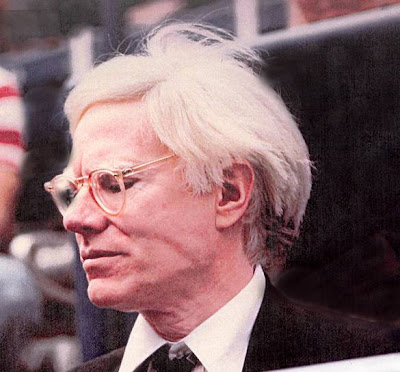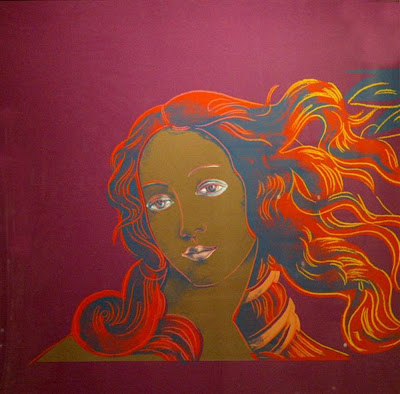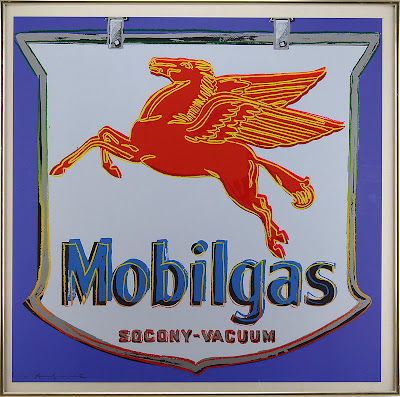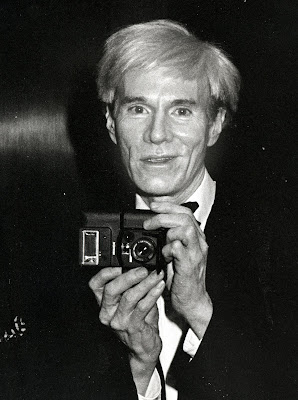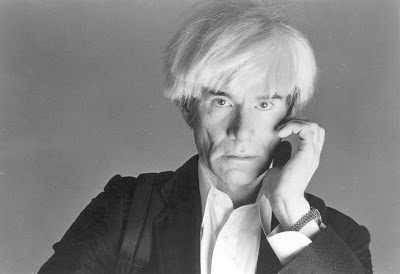Video: Andy Warhol’s Cinema: A Mirror to the Sixties
Nice 'Channel 4' documentary about Andy Warhol, his movies and The Factory.
Andy Warhol by Barbara Klemm (1981)
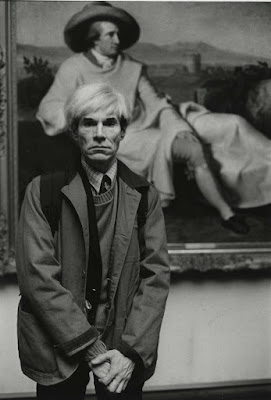 With an unobtrusive and sensitive eye, Barbara Klemm captures the individual essence of people, landscapes and objects. She contrives to reconcile journalistic ethic with personal opinion, information with emotion. Due to her yearlong work for the newspaper “Frankfurter Allgemeine Zeitung”, many of her photographs remain in the collective German memory.
With an unobtrusive and sensitive eye, Barbara Klemm captures the individual essence of people, landscapes and objects. She contrives to reconcile journalistic ethic with personal opinion, information with emotion. Due to her yearlong work for the newspaper “Frankfurter Allgemeine Zeitung”, many of her photographs remain in the collective German memory.
Barbara Klemm grew up in Karlsruhe where she was trained at the portrait studio Wilhelm Bauer. Today, she is living in Frankfurt am Main. In 1959, she started working for the “Frankfurter Allgemeine Zeitung”, from 1970 to her retirement in 2004 as editorial photographer for Politics and Features and Comments. She is considered one of Germany’s most important photographers and photographic witnesses of German postwar history. Barbara Klemm is a member of the Academy of Arts in Berlin and, since 2000, Honorary Professor for Photography at the Design Department of the FH Darmstadt.
'Large Flowers' (One Orange, One Purple) by Andy Warhol (1964) in high resolution
 The present work is one of only five monumental-scale paintings from Andy Warhol's famous Flowers series, which the artist showed at a sell-out exhibition at the Leo Castelli Gallery in New York in 1964 and with Galerie Sonnabend in Paris in May 1965. The two shows comprised of densely hung canvases of flowers in various sizes and brilliant Day-Glo hues, all appropriated by Warhol from a photograph of hibiscus blossoms that had appeared in the June 1964 issue of Popular Photography. Warhol was at the height of his creative powers and international fame, and as David Bourdon writes, the "cheerful and refreshing Flowers series includes some of Warhol's most lushly colored, decorative, and ingratiating paintings." (D. Bourdon)
The present work is one of only five monumental-scale paintings from Andy Warhol's famous Flowers series, which the artist showed at a sell-out exhibition at the Leo Castelli Gallery in New York in 1964 and with Galerie Sonnabend in Paris in May 1965. The two shows comprised of densely hung canvases of flowers in various sizes and brilliant Day-Glo hues, all appropriated by Warhol from a photograph of hibiscus blossoms that had appeared in the June 1964 issue of Popular Photography. Warhol was at the height of his creative powers and international fame, and as David Bourdon writes, the "cheerful and refreshing Flowers series includes some of Warhol's most lushly colored, decorative, and ingratiating paintings." (D. Bourdon)
The idea to paint flowers as the subject of a major series was apparently suggested to Warhol by Henry Geldzahler, then curator at the Metropolitan Museum in New York. To some degree, the pictures belong to a long art historical tradition of still-life painting. "With the Flowers, Andy was just trying a different subject matter. In a funny way, he was kind of repeating the history of art. It was like, now we're doing my Flower period! Like Monet's water lillies, Van Gogh's flowers, the genre." (Gerard Malanga).
Video: 'Sleep' by Andy Warhol (1963)
'Sleep' is one of the first films of Andy Warhol, which consists of long take footage of John Giorno (North American poet and performance artist), his closest friend at the time, sleeping for five hours. The film was one of the first Warhol's experiments with filmmaking, and was established as an "anti-film." Warhol later extend this method to his eight-hour-long film 'Empire'.
Sleep premiered on January 17, 1964, presented by Jonas Mekas (often called 'the godfather of American avant-garde cinema') at Film-makers' Cooperative. Of the nine people who attended the premiere, two left in the first hour.
Labels: Andy Warhol Videos, Sleep by Andy Warhol
Video: Andy Warhol interview (1964)
Another part of this interview in better quality
Labels: Andy Warhol interview, Andy Warhol Videos
Art links
Fine Art Galleries, Tattoo Artwork, Famous Artist Listing, Learning Art - Human-edited Art Resource
Art Resource directory with thousands of listings for fine art galleries, movements, fantasy art, tattoo artwork, 3d computer art, famous artist, history of art, museum listings, free tattoo flash, fairy tattoos, art chats and forums, and more. Add your website to our art directory database.
Art Industri -
The world of art at your fingertips, including artist portfolios, ecards,
resources, kids stuff, reference guides, free email, magazine and web design.
Over 500 exclusive paintings in photorealistic, realistic and impressionistic styles. ART catalogue, purchase & sale of paintings, painting lessons.
Labels: Art links
Video: 'Blowjob' directed by Andy Warhol (1963)
This summary is not available. Please click here to view the post.
Video: Andy Warhol and Jean-Michel Basquiat (1986)
This is from the final episode of State of the Art, a series of documentaries about the visual arts in the 1980s.
Filmed in Europe, the United States and Australia in 1985-6, the six programmes feature many key artists including - in addition to Basquiat and Warhol - Cindy Sherman, Antony Gormley, Hans Haacke, Eric Fischl and Joseph Beuys. The films also explore the intellectual context of the time and the ideas of post-modernism.
The series was originally seen on Channel 4 in Britain, and then shown in more than 20 countries.
Video: Andy Warhol interview
Andy is not giving a reporter any chance, answering 'yes' or 'no' only.
Labels: Andy Warhol interview, Andy Warhol Videos
Video: That's why they call it Art (Andy Warhol)
- Do you want me to tell you about Andy?
- Oh, go ahead.
- Anything Andy does is fantastic because he's a saint.
- A saint?
- Yeah.
- St. Andy the First.
- He really loves people, so anything he does is beautiful because he sees the best in everybody.
- Mmm-hmm.
- He sees God wherever he looks, and in whoever he looks at. So that's why they call it art, because he's just very good, you know, he's very pure so they call it art, that's what they call art, and some things...just done, um, with a touch of divinity.
- Fudge.
- What?
- Fudge.
Video: Andy Warhol: Re-Reproduction
Strange short movie directed by Toshio Matsumoto in 1974. The movie consists of a kaleidoskopic image of Andy Warhol, presumably found footage from some interview. The image is slowed down and played over sudden bursts of white noise and Warhol's own distorted, delayed, voice. It doesn't really get anywhere, it's an experimental short after all, it's not meant to reaffirm preconceived notions of form but rather play with them, deconstruct them, and piece them back together in different abstract ways, see what comes of it.
'Robert Mapplethorpe Portrait Unique' by Andy Warhol (1983) in high resolution

Robert Mapplethorpe (November 4, 1946 – March 9, 1989) was an American photographer, known for his large-scale, highly stylized black and white portraits, photos of flowers and naked men. The frank, homosexual eroticism of some of the work of his middle period triggered a more general controversy about the public funding of artworks.
Inspired by Andy Warhol's film Chelsea Girls (1966), Robert Mapplethorpe moved to Manhattan in 1969 to meet the artist and to emulate him-in art, lifestyle, and material success. After he settled at the Chelsea Hotel, where segments of Warhol's film were shot, he began making photographs, often self-portraits or portraits of his roommate, the poet Patti Smith, and usually with a borrowed Polaroid camera.
Mapplethorpe's maturing approach to photography resembled Warhol's in many ways. He had no patience for the technical side of the medium and prided himself on gaining a reputation without ever having made a print himself. Portraiture was his main theme, and he used the camera as a means of making connections with celebrities, potential patrons, and possible lovers. In the 1980s, sales of Mapplethorpe's pictures soared. Warhol was commissioned to paint his portrait, so Mapplethorpe sat for the preparatory Polaroids, including this one. In turn, Warhol sat for Mapplethorpe in 1986.
'Reigning Queens: Queen Elizabeth II of the United Kingdom' (Dark Outline) by Andy Warhol (1985) in high resolution
Andy Warhol’s iconic image of Her Majesty Queen Elizabeth II hovers between the formality of a traditional portrait and the brashness of modern advertising. The photograph on which the image is based is an official Jubilee portrait taken in 1977. This vibrant screenprint is one of a number of portraits of Elizabeth II from a series by Warhol entitled Reigning Queens, which also includes images of the Queens of Denmark and the Netherlands. The technique of screenprinting enabled him to repeat the image with different colour combinations. Each block of colour is slightly misaligned, suggesting the imperfections of mass-produced commercial images.
'Double Marlon' by Andy Warhol (1966) in high resolution
 Executed in 1966, Double Marlon celebrates a male icon. Warhol placed the double image of Marlon Brando, taken from his highly influential and controversial 1953 movie The Wild One, at the right-hand edge of a vast, deliberately unprimed canvas. Leaning languidly on his motorcycle's handlebars, dressed in the leather of his role as the menacing and rebellious biker gang leader, Brando is here presented as an equal to Warhol's other favored screen idols, be it Marilyn Monroe, Elizabeth Taylor or Elvis Presley. And as in his works showing those stars, Double Marlon has a dark undercurrent. Where Marilyn had died, Liz was rumoured to be at death's door and Elvis was shown as a gun-toting cowboy, Brando oozes violence, volatility and antiestablishment subversion. Where Warhol celebrated those other stars in an array of works, he created only eight images of Marlon in 1966, and a single example on silver in 1963.
Executed in 1966, Double Marlon celebrates a male icon. Warhol placed the double image of Marlon Brando, taken from his highly influential and controversial 1953 movie The Wild One, at the right-hand edge of a vast, deliberately unprimed canvas. Leaning languidly on his motorcycle's handlebars, dressed in the leather of his role as the menacing and rebellious biker gang leader, Brando is here presented as an equal to Warhol's other favored screen idols, be it Marilyn Monroe, Elizabeth Taylor or Elvis Presley. And as in his works showing those stars, Double Marlon has a dark undercurrent. Where Marilyn had died, Liz was rumoured to be at death's door and Elvis was shown as a gun-toting cowboy, Brando oozes violence, volatility and antiestablishment subversion. Where Warhol celebrated those other stars in an array of works, he created only eight images of Marlon in 1966, and a single example on silver in 1963.
The Wild One was a hugely influential film at the time of its release, and was banned for many years in the United Kingdom and other countries for fear of copycat crime sprees and because of concerns that the film might glorify and glamorize violence and rebellion. It tells the story of a motorcycle gang -- the Black Rebel Motorcycle Club (from which the band would later take its name) -- that descends upon a 1950s town, causing havoc. This chaos only increases when Chino -- played by Lee Marvin -- arrives with his rival gang, the Beetles (also considered by some to have inspired a band's name), intent on picking a fight with the B.R.M.C. The local townsfolk, though, take the law into their own hands and appear as the film's real villains, their actions resulting in the death of a kindly old man. Brando's character, Johnny, would serve as a template for bad boy characters for decades. Just as his role as Stanley Kowalski in A Streetcar Named Desire created a vogue for plain white tees, so too Johnny's leather jacket became a must-have for wannabe rebels throughout the United States. Once more, he had defined cool. Brando's brooding performance, his sheer beauty and minimal morals would all echo down the decades in the template of the antihero even this day.
It was only natural that, in 1963, Warhol should have turned to the image of Brando leaning on his motorbike to create a silver-backed altarpiece to cool, subsequently returning to it three years later in Double Marlon, where Brando's raw machismo is reflected in the rawness of the unprimed canvas. Brando's character in the film even has a Warholian aspect in some of his terse dialogue, especially in what are perhaps the most famous lines, when Kathie asks, "What're you rebelling against," to which he opaquely replies, "What've you got?" Johnny's all-out, motiveless, empty war on the status quo was arguably echoed in the gauntlet that Warhol himself would take up with Pop almost a decade later.
Warhol had long looked to cinema for his heroes and heroines as well as his inspiration. Long a worshipper of the silver screen, some of his best known and most celebrated images were those of the era's stars, who found themselves beneficiaries of a strange canonization. The promotional photos and postcards for a range of films became the raw materials which Warhol used to raise them onto new pedestals in the art gallery, within the hallowed realms of High Art. Simultaneously, Warhol, in his own Brando-like rebellion, undermined those selfsame hallowed realms by filling them with all-too-real and all-too-everyday emblems of the popular and the pulp. In his Marilyn, Liz or even his Campbell's Soup Cans, Warhol was gleefully undermining high-falutin' ideas about art and inspiration on the one hand while celebrating the banal on the other.
This would also become the case in Warhol's own movies, for it was at precisely the time that he created Double Marlon that Warhol was at the height of his own brief, meteoric cinematic career. This picture, executed in the same year as films such as The Chelsea Girls, shows how involved Warhol still was in film at the time, both as viewer and director. Warhol had long adulated the stars of the screen; at the same time, during the early 1960s, he had become a regular on the underground film circuit in New York, attending many viewings of experimental movies. From the moment in 1963 when he bought his own first camera, a Bolex limited to three-minute reels, he became a filmmaker, showing his own films on this same circuit. He was a fan of Hollywood movies, loving the glamour and the drama, while also being an inspired innovator in his own right. His films had come to be so important to him that, the year before he made Double Marlon, he had claimed that he had retired from making pictures, and in 1966 reiterated: "I don't paint any more, I gave it up about a year ago and just do movies now. I could do two things at the same time but movies are more exciting. Painting was just a phase I went through". He exaggerated, but it is noteworthy that Double Marlon dates from a period when he made relatively few pictures, focusing more on film. This shows his clear enthusiasm for the theme, while at the same time the composition of Double Marlon hints at his preoccupation with film: the vertical strip of the two shots of Brando comes to resemble a strip of celluloid, while the large space left deliberately in reserve, heightening the impact of the images, also resembles a screen awaiting projection. In this light, it even recalls the dual projection techniques that Warhol had used in The Chelsea Girls.
Warhol's return to the theme of the biker in 1966 may in part have had something to do with Scorpio Rising, a film made in 1964 by a fellow experimental cinematographer, Kenneth Anger.
Certainly in a 1966 interview, Warhol showed that he had seen and admired Anger's film, saying "Kenneth Anger's Scorpio Rising interested me, it's a strange film... it could have been better with a regular sound track, such as my Vinyl, which dealt somewhat with the same subject but was a sadism-masochism film. Scorpio was real but Vinyl was real, and not real, it was just a mood".
Anger's groundbreaking film featured a montage following a biker, Scorpio, shown preparing himself, donning his leather, joining a gang who make their engines roar, all culminating in a massive, chaotic party. All this was interspersed with a strange and bewildering array of images, played against a soundtrack that included Elvis and Ray Charles. Importantly, it was not only the technology of the motorcycles that was fetishized through lingering shots of gleaming metal, but also the bikers themselves, celebrated in lingering shots of gleaming skin.
Warhol's Double Marlon reflected the artist's own admiration of and possible desire for the handsome actor. The image of the biker, formerly the outcast and rebel, had been through the dual grinder of Warhol's art and Anger's films, resulting in an image that speaks of a different manner of outcast. At the same time, Warhol doubtless revelled in the chance to puncture the manly appearance of the menacing biker, subversively presenting Brando as, in several senses, a man's man. Warhol would take this notion to a new extreme when he created his own biker film, Bike Boy, the following year.
Warhol accentuates Brando's own sensuality, so evident in The Wild One and in this picture with the warm hues of the canvas itself. Double Marlon is exceptional in terms of depicting Brando, in terms of its scale, and also in terms of the experimental technique of its execution. Using the same screen he had used to create a silver image of the actor three years earlier, Warhol applied the inks to a raw, unprimed canvas, resulting in the unique visual effect of Double Marlon and its handful of sister pictures. In this picture, the effect is emphasized by the deliberate use of a large swath of canvas which has been left in reserve. This serves both to thrust the image's black inks into relief and to heighten awareness of the sensual texture of the canvas itself. Warhol celebrated the raw materials of painting, as well as the image, in Double Marlon.
The Catalogue Raisonné points out that the Marlon paintings relate to no commission or exhibition but were a spontaneous creation resulting from Warhol's own inspiration. This suggests that they may have been the Pop artist's retort to Clement Greenberg's advocacy of Post-Painterly Abstraction. Greenberg, the critic who had hailed Abstract Expressionism as the dawn of a new artistic age but who had so summarily dismissed Pop Art, believed that the purity and truth of the canvas could be revealed through the application, through non-gestural means, of color, as in the paintings of Ellsworth Kelly and Frank Stella, or in the deliberate techniques for staining the canvas used by Morris Louis and Helen Frankenthaler. In this sense, the warm, glowing canvas that forms so much of Double Marlon is pure indeed, taking Greenberg at his word, forming a color field that bears no gestural signature of the artist, but whose distinct and emphatic figuration in the double image of Brando adds a sly, critical twist of the knife.
'Kiku' by Andy Warhol (1983) in high resolution
 Capitalizing on Warhol's strong appeal to Japanese collectors, members of the Gendai Hanga Center in Tokyo asked Warhol in 1982 to create a body of work specifically for them, focusing in particular on images of flowers. Warhol agreed, and created a beautiful series of images inspired by the chrysanthemum (the traditional symbol representing the Japanese emperor and Imperial House). The exhibition was a success and Warhol's exquisite prints for the "Kiku" (the Japanese word for chrysanthemum) exhibition have since become highly regarded by both critics and collectors.
Capitalizing on Warhol's strong appeal to Japanese collectors, members of the Gendai Hanga Center in Tokyo asked Warhol in 1982 to create a body of work specifically for them, focusing in particular on images of flowers. Warhol agreed, and created a beautiful series of images inspired by the chrysanthemum (the traditional symbol representing the Japanese emperor and Imperial House). The exhibition was a success and Warhol's exquisite prints for the "Kiku" (the Japanese word for chrysanthemum) exhibition have since become highly regarded by both critics and collectors.
'Vesuvius' by Andy Warhol (1985) in high resolution

Andy Warhol left his beloved serigraphies and photographic manipulations to experiment something different for the first time in 1985, when he created the series 'Vesuvius by Warhol', 18 paintings that the artist dedicated to the Italian volcano.
The American pop-art icon portrayed the volcano in the 'catastrophic' act of eruption, which is immortalized at different hours of the day, from dawn to sunset. Thanks to the various chromatisms, as the artist explained in an interview "the volcanoes seemed to be painted just one minute after the eruption." A range of visions and feelings that are also conveyed by the black and white photography, which are Warhol's favourite colours and those easiest to remember.

'In The Bottom of My Garden' by Andy Warhol (1956) in high resolution
 This is the image from a book illustrated by Andy Warhol in 1956. Unlike prior works in this period, Warhol relies solely on imagery to depict his meaning in this work. This widely expressive account of faeries and putti, as they cavort in a garden, includes two references to J.J. Grandeville's 1884 work, "Les Fleurs Animée." Grandeville was one of the most important illustrators of Warhol's time, specializing in surrealist drawings that featured anthropomorphic interpretations of animals and flowers.
This is the image from a book illustrated by Andy Warhol in 1956. Unlike prior works in this period, Warhol relies solely on imagery to depict his meaning in this work. This widely expressive account of faeries and putti, as they cavort in a garden, includes two references to J.J. Grandeville's 1884 work, "Les Fleurs Animée." Grandeville was one of the most important illustrators of Warhol's time, specializing in surrealist drawings that featured anthropomorphic interpretations of animals and flowers.
One of the most important things to note, when studying these exuberant baroque-like drawings, is how Warhol's personality seems to shine through more than with his iconic pop art. His encoded sexuality and fey sensibility seem to shine through as Warhol fights to discover himself, as an artist, without the limitations of being micro-managed by some art directors. (This was especially difficult in a period so addicted to the rise of abstract expressionism.) The most obvious outpouring of Warhol's sexuality can be found in the title alone. "In the Bottom of My Garden" was named after a song by Rose Fyleman and Liza Lahmann entitled, "There are Fairies in the Bottom of My Garden." This song was popularized by Beatrice Lillie, the woman who Warhol depicted in one of his gold shoe collages and who also served as one of the leading gay icons of her time. This process foreshadows the processes he used in 1974's "Flowers (Hand-Colored)" and in the trial proofs of the 1980's.
'Absolut Warhol' Print Ad by Andy Warhol (1985)
 In 1985 Andy Warhol said that he would like to paint the Absolut bottle, no one could have predicted that this would be the foundation of an extraordinary collection of contemporary works of art from all over the world. Since then, art has become an important medium to express the spirit of Absolut Vodka.
In 1985 Andy Warhol said that he would like to paint the Absolut bottle, no one could have predicted that this would be the foundation of an extraordinary collection of contemporary works of art from all over the world. Since then, art has become an important medium to express the spirit of Absolut Vodka.
Warhol was the first artist to demonstrate his own interpretation of Absolut Vodka, and since "Absolut Warhol", there have been works in every conceivable form of visual art, from over 600 artists from around the globe.
Video: Andy Warhol Japanese TDK commercial
Japanese presenter speaks English while Andy Warhol speaks Japanese:)
Video: Andy Warhol and Sonny Liston in Braniff Airlines Commercial
Quite funny commercial. Andy Warhol talks to former world heavyweight boxing champion Sonny Liston about "the inherent beauty in soup cans that Michelangelo could not have imagined existed."
Video: Andy Warhol eating a hamburger
This is not a Burger King product placement. In fact it's a scene from a documentary by Jorgen Leth filmed in 1982.
Andy Warhol tries to cope with a nice hamburger. Unfortunately, the Danish director forgot to buy coke or any other beverage for this scene:)
Video: The Cars 'Hello Again' music video directed by Andy Warhol
In 1984 Andy Warhol together with Don Monroe directed a video for then-popular rock-pop band 'The Cars'. Warhol starred in the video himself as a bartender.
Can't say that I like the song, but they show tits there few times, so it's definitely worth watching:)
Video: Andy Warhol paints Debbie Harry on an Amiga (1985)
Really interesting and amusing video from the Commodore Amiga product launch press conference in 1985. It was even before Photoshop:)
Video: Andy Warhol Talks About His Paintings
Andy Warhol and Warhol superstar Brigid Berlin describe how Warhol was able to make the thousands of paintings he had created. The talk about 'Electric Chair' paintings in particular.
BMW M1 Art Car by Andy Warhol (1979)
A can of Campbell’s soup, it’s not. But Andy Warhol still considered the BMW “art car” he designed to be a masterpiece. “I adore the car. It’s much better than a work of art,” Warhol said in 1979 when he hand-painted a BMW M1 in bold strokes of red, green, yellow and blue blurred into each other to portray speed. The BMW art car project, a continuing effort which commissions artists to use BMW cars as their canvas has produced 16 art cars since the first car designed in 1975 by American artist Alexander Calder. All previous Art Car artists created their designs on 1:5 scale models, called maquettes, and had technicians reproduce their designs on the real cars. Warhol insisted on painting the real M1 himself. The car raced only once, in the 24 Hours of Le Mans in 1979, driven by Manfred Winkelhock (Germany) and the Frenchmen Hervé Poulain and Marcel Mignot. It placed sixth overall and second in class.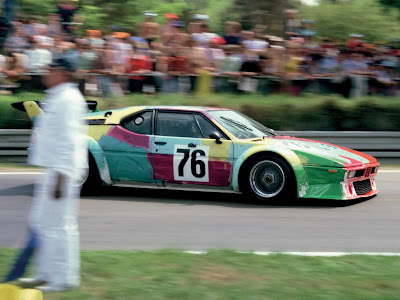

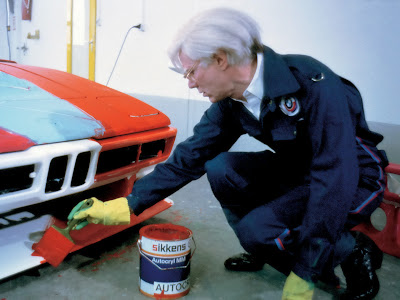


Video: Fifteen Minutes - Candy Darling and Andy Warhol (in two parts)
Candy Darling (November 24, 1944 – March 21 1974) was an American Warhol Superstar. A transsexual, she starred in Andy Warhol's films Flesh (1968) and Women in Revolt (1971), and was a muse of the protopunk band The Velvet Underground.
Candy Darling was born James Lawrence Slattery in Forest Hills, Queens, the son of Theresa Phelan, a bookkeeper in Manhattan Jockey Club, and James (Jim) Slattery, who was described as a violent alcoholic. There are several hypotheses around the year of birth. According to a former employee Warhol, Bob Colacello, Candy was born in 1946, while IMDb has listed her year of birth in 1948. Her friend, neighbour, and posthumous editor, Jeremiah Newton, states that she was born Nov. 24, 1944.
The early years - as a man - have been spent on Massapequa Park, Long Island, where she and her mother moved after her parents divorced. Her half-brother Warren, the works of Theresa Slattery first marriage, left home for the U.S. military, with the result that Jimmy as soon as a child; Warren later denied his relationship with him.
She spent most of his childhood absorbing the impact of U.S. television and old Hollywood films, with whom she has learned to impersonate her favorite actresses such as Joan Bennett and Kim Novak. She argued that she have "learned about the mysteries of sex from a salesman in a local children's shoe store", and finally, has shown the propensity to dress as a woman, when her mother confronted her about local rumors that described her dressed as a girl attending the local gay bar called The Hayloft. In response Jimmy left the room and reappeared in full feminine attire. Her mother later said,"I knew then... that I couldn't stop Jimmy. Candy was just too beautiful and talented."
Late at night, would often take a taxi Candy (thus avoiding the attention of neighbours, she would receive if she walked) a short distance to the Long Island Rail stations on the train to Manhattan, often sat opposite the Long Island actress Joey Heatherton. . Once there, she referred to her Cape Cod-style home at 79 First Avenue in Massepequa Park as her "country house" and hung out in Greenwich Village, meeting people through the circle of Seymour Levy on Bleecker Street.
Her first assumed name was Hope Slattery. According to Bob Colacello, Candy adopted this name sometime in 1963/1964 after she began going to gay bars in Manhattan and visiting doctor on Fifth Avenue for hormone injections. Jackie Curtis said that Candy had adopted the name of a well-known Off-Broadway actress named Hope Stansbury, with whom she lived for several months in an apartment for the Caffe Cino so that she could study her. Holly Woodlawn remembers that Candy name evolved from Hope Dahl to Candy Dahland then to Candy Cane. Jeremiah Newton believes Candy took its name from the love of sweets. Jeremiah Newton believed Candy adopted her forename out of a love for sweets. In her autobiography, Woodlawn recalled that Candy had adopted the last name of Darling because a friend of hers affectionately called Candy "darling" so often that it finally stuck.
Before they actually met in 1967, Candy saw Andy Warhol at the after-hours club called The Tenth of Always. Candy was with Jackie Curtis, who invited Warhol to the play she wrote and directed called 'Glamour, Glory and Gold'. It was performed at Bastiano's Cellar Studio on Waverly Place. Taylor Mead brought Andy to see it, and then went to the Salvation club in Sheridan Square, where he was joined by Candy and Jackie by his table.
Warhol cast Candy in a short comedic scene in Flesh (1968) with Jackie Curtis and Joe Dallesandro. After Flesh, Candy was cast in a central role in Women In Revolt (1971). She played a Long Island socialite drawn into a woman's liberation group called PIGS (Politically Involved Girls) by a character played by Curtis. Interrupted by cast disputes encouraged by Warhol, Women in Revolt took longer to film than its predecessor and went through several title changes before a consensus was reached. Candy wanted it called Blonde on a Bum Trip since she was the blonde, while Jackie and Holly told her it was more like "Bum on a Blonde Trip" — titles which were both used in the film during Candy's interview scene.
Women in Revolt was first shown at the first Los Angeles Filmex as Sex. Later it was shown as Andy Warhol's Women, an homage to George Cukor. Unable to get a distributor for the film, Warhol rented out the Cine Malibu on East 59th Street and launched the film with a celebrity preview on February 16, 1972. After the screening there was a dinner in Candy's honor at the restaurant, Le Parc Perigord on Park Avenue at 63rd Street, followed by a party at Francesco Scavullo's townhouse round the corner, where they watched TV reviews of the movie. They watched it being called "a rip-off", that it "looked as if it were filmed underwater," and "proves once again that Andy Warhol has no talent. But we knew that since the Campbell's Soup cans."
Among the guests at Candy's party were D.D. Ryan, Sylvia Miles, George Plimpton, Halston, Giorgio di Sant 'Angelo and Diane and Egon von Furstenberg. Jackie Curtis stood out in the cold, along with other gate crashers. When a security guard asked, "My God, what are they giving away in there?" one of the guests responded, "Would you believe, a transvestite?"
The day after the celebrity preview a group of women wearing army jackets, pea coats, jeans and boots and carrying protest signs demonstrated outside the cinema against the film, which they thought was anti-women's liberation. When Candy heard about this, she said, "Who do these dykes think they are anyway?... Well, I just hope they all read Vincent Canby's review in today's Times. He said I look like a cross between Kim Novak and Pat Nixon. It's true - I do have Pat Nixon's nose."
Candy Darling went on to appear in other independent films, including Brand X by Wynn Chamberlain, Silent Night, Bloody Night, as well as a co-starring role as a victim of gay bashing in Some of My Best Friends Are...
She also appeared in Klute with Jane Fonda and Lady Liberty with Sophia Loren. In 1971 she went to Vienna to make two films with director Werner Schroeter; The Death of Maria Malibran, and another one that was never released. Her attempt at cracking the mainstream movie circuit — by campaigning for the leading role in Myra Breckinridge (1970) — led to rejection and bitterness.
Theatre credits include two Jackie Curtis plays, Glamour, Glory and Gold (1967) and Vain Victory: The Vicissitudes of the Damned (1971), and Tennessee Williams' play, Small Craft Warnings, at the invitation of Williams himself. She also starred in the 1973 Off-Broadway revival of The White Whore and the Bit Player, a 1964 play by Tom Eyen. Darling's character, a Hollywood actress known only as "the Whore", was based on Marilyn Monroe. As a review of the play stated, "With her teased platinum hair and practiced pouts, Miss Darling looks like her character and resolutely keeps her acting little-girl-lost. The role-playing aspect works to her advantage. She could, after all, be a male lunatic pretending to be the White Whore."
Candy died of leukemia on March 21, 1974, aged 29; she died at the Columbus Hospital division of the Cabrini Health Center.[3] In a letter written on her deathbed and intended for Andy Warhol and his followers, Darling said, "Unfortunately before my death I had no desire left for life . . . I am just so bored by everything. You might say bored to death. Did you know I couldn't last. I always knew it. I wish I could meet you all again."
Her funeral was attended by huge crowds, including friends Pat Ast and Julie Newmar; a piano piece was played by Faith Dane; Gloria Swanson was remembered for saluting Darling's coffin. The New York Times honored her request that her obituary should appear on the front page.
Candy Darling was cremated, her ashes interred by her friend Jeremiah Newton in the Cherry Valley Cemetery, located in Cherry Valley, New York, a tiny historical village located at the foot of the Catskill Mountains.
Video: Warhol Photo Exhibition (1987)
I recorded this footage on January 6, 1987 during the opening of Andy Warhol's photo exhibition held at the Robert Miller Gallery, then located at 41 East Sixth Street, New York, NY. In the beginning of the video, he autographs a 1961 copy of Amy Vanderbilt's Complete Cookbook for which he had done the illustrations prior to becoming well known for his pop art creations. Later in the video he autographs my friend's face and then adds marks to a small photo of Henry Geldzahler. Also in the video, Warhol uses his camera to shoot photos and others take photographs of him. There are interesting moments when camera flashes go off illuminating high contrast, still frames. Tragically, Warhol died 47 days later on February 22, 1987. This video may be among the last of him to have been recorded in public.
Video by Nicholas Maravell
Jane Holzer by Andy Warhol (1976)
 Jane Holzer (born October 23, 1940) is an American art collector and film producer who was previously an actress, model, and Warhol superstar. She was often known by the nickname Baby Jane Holzer.
Jane Holzer (born October 23, 1940) is an American art collector and film producer who was previously an actress, model, and Warhol superstar. She was often known by the nickname Baby Jane Holzer.
Born as Jane Brookenfeld to Carl Brookenfeld, a real estate investor, she married to Leonard Holzer, an heir to a New York real estate fortune.
Movies she appeared in included Soap Opera, Couch and Ciao! Manhattan.
She co-produced the 1985 film Kiss of the Spider Woman.
Subject of "Girl of the Year" in Tom Wolfe's The Kandy-Kolored Tangerine-Flake Streamline Baby 1963



